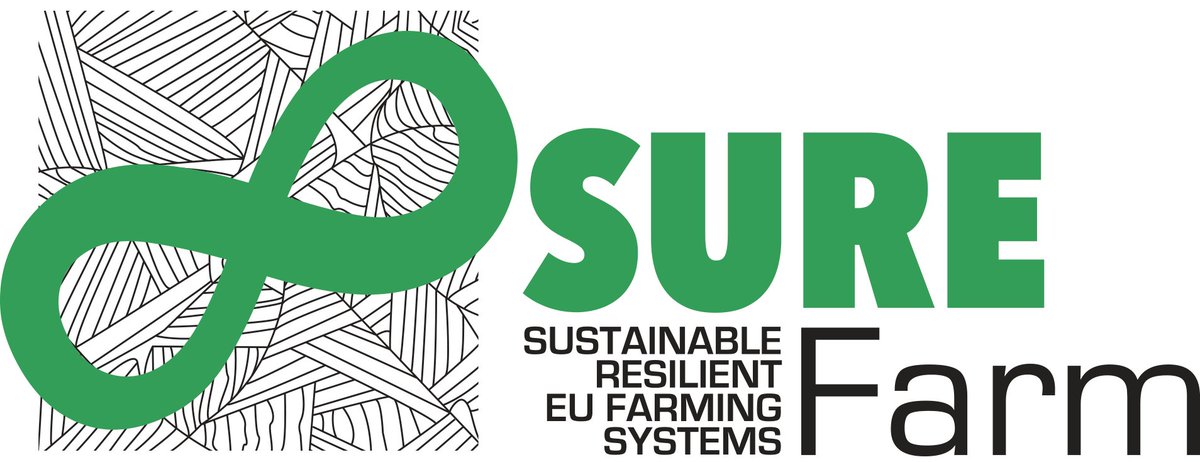Published – 13 May 2020 By Gavin Beever
As farming systems face more volatility with things such as prices, input costs and weather events; as well as more complex social changes/challenges/consumer preferences, environmental and government/political policy issues –
“Resilience theory provides an integrated framework to investigate the ability of complex social-ecological systems to cope with changing environments (Folke et al., 2010).”
The SURE Farm (sustainable, resilient, EU farming systems) project in their report (Meuwissen et al 2018) propose a resilience framework to help develop strategies to address the complex challenges farmings systems face.
Although this project has a European focus, there are learnings that can be applied to farming systems around the world, that face similar challenges and have to adapt to changing conditions. See a short introductory video to the project below.
The Sure Farm resilience framework recognises that farmers need the support of up-to-date government policies and private initiatives to overcome the challenges they face and to be able to adapt to changing conditions. To do so requires comprehensive research to accurately assess the complexity of the farming sector.
Farming systems are complex systems characterised by among others, institutions and agro-ecological context.
“Previous resilience frameworks do not sufficiently capture this complexity. Also, previous frameworks do not distinguish between different types of resilience thereby diminishing the spectrum of solutions to enhance resilience. We distinguish 3 main adaptive cycle processes pertaining to farming systems, i.e. agricultural, farm demographics and governance processes, and build our framework around three types of resilience: robustness, adaptability and transformability. Exploring resilience is preceded by defining spatial, functional and temporal boundaries.” (Meuwissen et al 2018)
In that context, the project has brought together 16 Universities and Research Institutes to study how to improve farm resilience across Europe. They have developed 11 case studies across different farming sectors. In doing so they have worked closely with farmers and also other key stakeholders; such as suppliers, distributors and financial institutions. To gain insight into their main risks and key challenges and to co-create improved risk management strategies.
The Sure-Farm project is also developing new tools to assess changes in farm demographics and has designed a pathway to implement a resilience enhancing environment.
Their efforts aim to:
- Understand farmer’s risk exposure
- Support the decision making of government legislators
- Guarantee the resilience of European agriculture
The project proposes that developments in agriculture can only be understood if multiple processes that may be in play, can be considered simultaneously. They emphasise three main adaptive processes that are essential for EU farming systems:
- Agricultural production processes
- Farm demographics
- Governance processes
The adaptive cycles and interwoven processes they have identified (shown below), they believe give farming systems the capability to adapt and transform in light of the risks that are faced. The report points out that the processes shown are not as regular as depicted, but they believe the domain of each component of the adaptive cycle, can be distinguished.
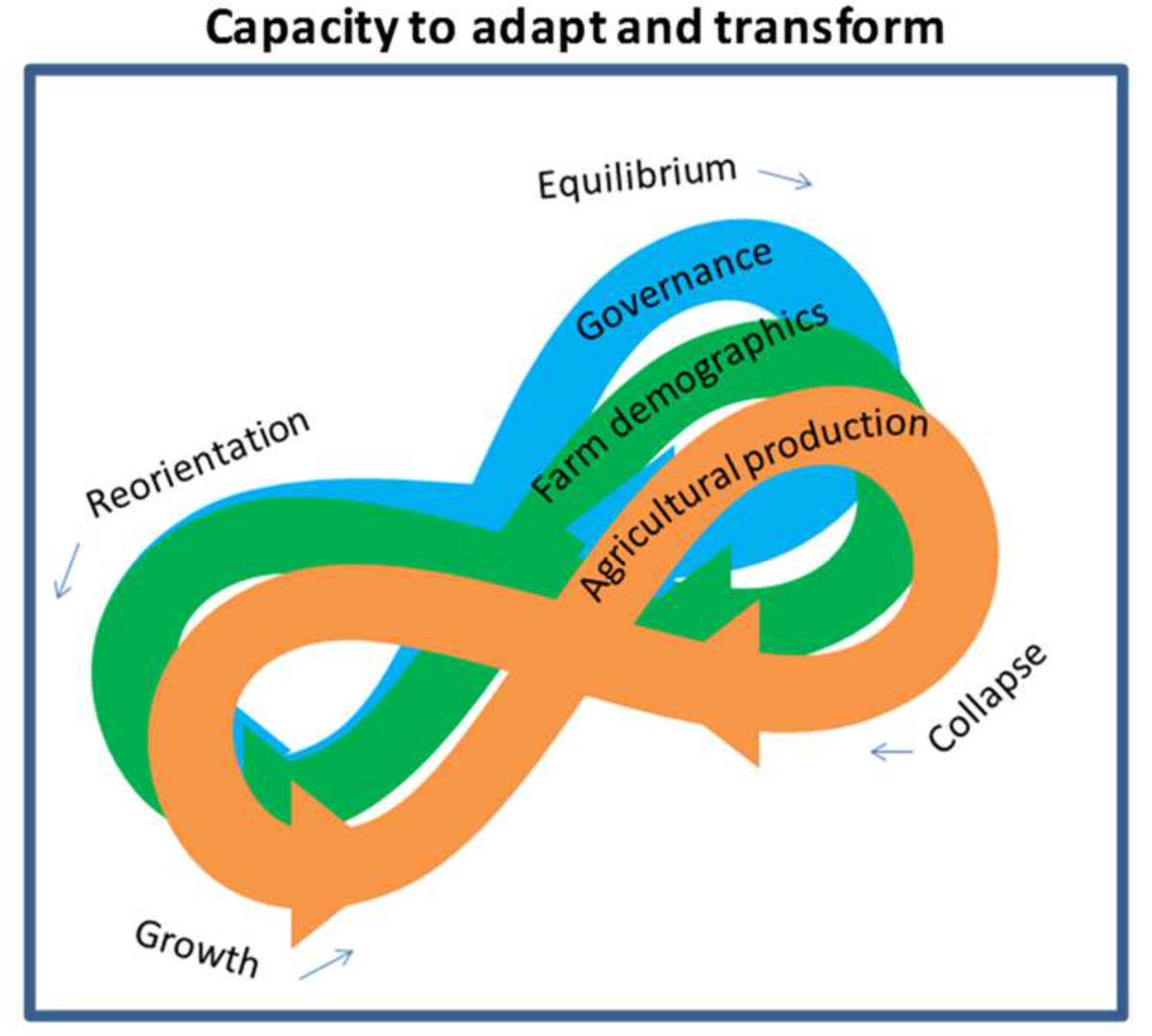
The ability to carry out the essential functions of the farming systems: The production of private and public goods, they report as being influenced by key risks:
- Economic
- Environmental
- Social
- Institutional
The report explains that adaptive agricultural production cycles have been analysed since the recognition of the hog cycle (high prices trigger an increase in breeding of pigs, which a year or so latter leads to an oversupply and a subsequent reduction in prices) and the consequent development of the cobweb model (the cycles of supply and demand overtime create graphs that give a cobweb effect), (Hanau 1927, Ezekiel 1928).
The Sure Farm report goes onto recognise that the cycles are fair more complex than just price and supply responses and are becoming increasingly influenced by factors such as societal perceptions around animal welfare, environmental influences and political developments such as embargoes and other trade barriers.
Their report states such factors lead to farmers adapting their production systems and developing products to meet new market needs and thereby creating new adaptive cycles. They also explain that cycles in demographics also greatly influence things, particularly in relation to generational change on farm (competition with other employment opportunities for the next generation); corporate farming employment and the demand and cycles in employment created by changes in technology and it’s impact on farm labour.
“The range of factors farmers and their farming systems face are creating and influencing cycles within the demographics of the farming sector.”
A key point is that phases in one cycle can have a great influence on the dynamics of the other cycles. E.g. interest rates, supply and demand and prices, can all have a great impact on farm demographics. Changing farm scale also has an adaptation to “push and pull” factors.
In respect to governance, the SureFarm project recognises that processes occur and interact at multiple levels: Local, regional, national and international and all can have adaptive cycles acting in relation to each of them.
Risk factors often relate to production and price risks and they propose that different adaptive cycles have evolved to manage those risks.
“The resilience framework essentially aims at understanding the dynamics of a farming system’s provision of it’s essential functions while facing a number of challenges, i.e. resilience does not reflect separate properties of a system, but describes the dynamics and the attributes contributing to those dynamics.”
“Systems are resilient if they have the capacity to adapt to changing circumstances and challenges while maintaining their core functions, including the delivery of their vital goods and services.”
“At the heart of the resilience thinking is the concept of adaptive cycles that consist of four stages: Growth, equilibrium, collapse and reorientation. The transition from one stage to another is always a possibility, if external circumstances change.”
“Preliminary applications of the framework in the SURE-Farm case study regions illustrates that the framework can be applied in a farming system context, enabling the ability to explore robustness, adaptability and transformability to specific risks.”
Processes are interrelated
The report proposes that as one cycle moves through different phases, it can influence the dynamics of other cycles.
“Before analysing a system’s dynamics and resilience attributes, one must first specify the system boundary and its configuration (‘resilience of what’), the challenges of interest to the system (‘resilience to what’), and the essential functions of the system (‘resilience for what purpose’), see also Carpenter et al. (2001) and Herrera (2017).”
“System characteristics, challenges, and interpretation of attributes are dynamic concepts (complex systems continually change). Even the essential functions of farming systems change over time. Such dynamics complicate the analyses of resilience indicators and the identification of resilience enhancing attributes.”
Characterising the farming system (Resilience of what)
Characterising the farming system is the first step SureFarm take in there framework shown below:
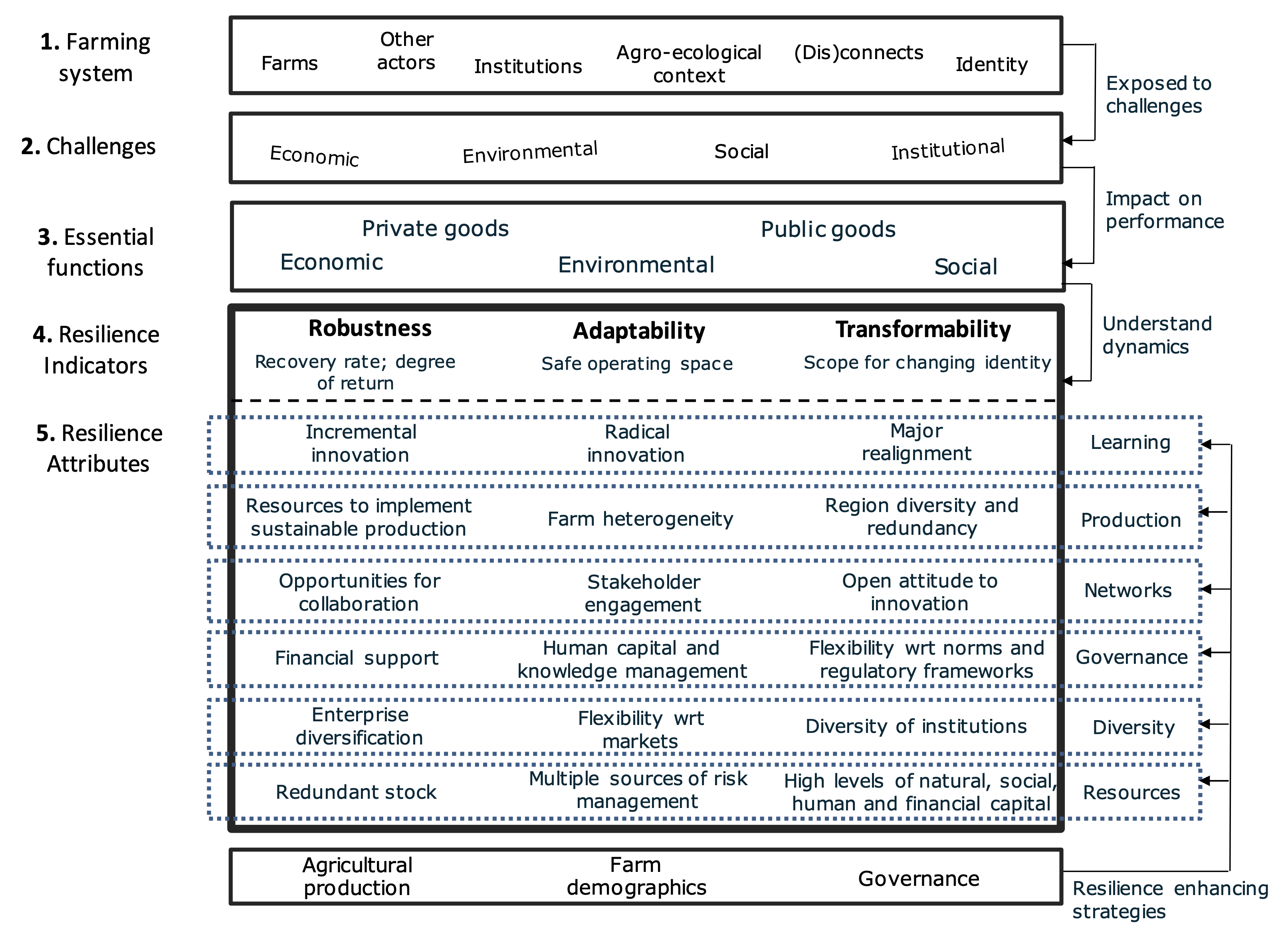
They identify key actors within the system boundary by using the following selection criteria, i.e. the boundary of a farming system is such that they include actors who influence farms, and, conversely, farms also influence these actors. In contrast, they exclude actors who influence the farming system, but who are themselves scarcely influenced by the system, see the diagram below.
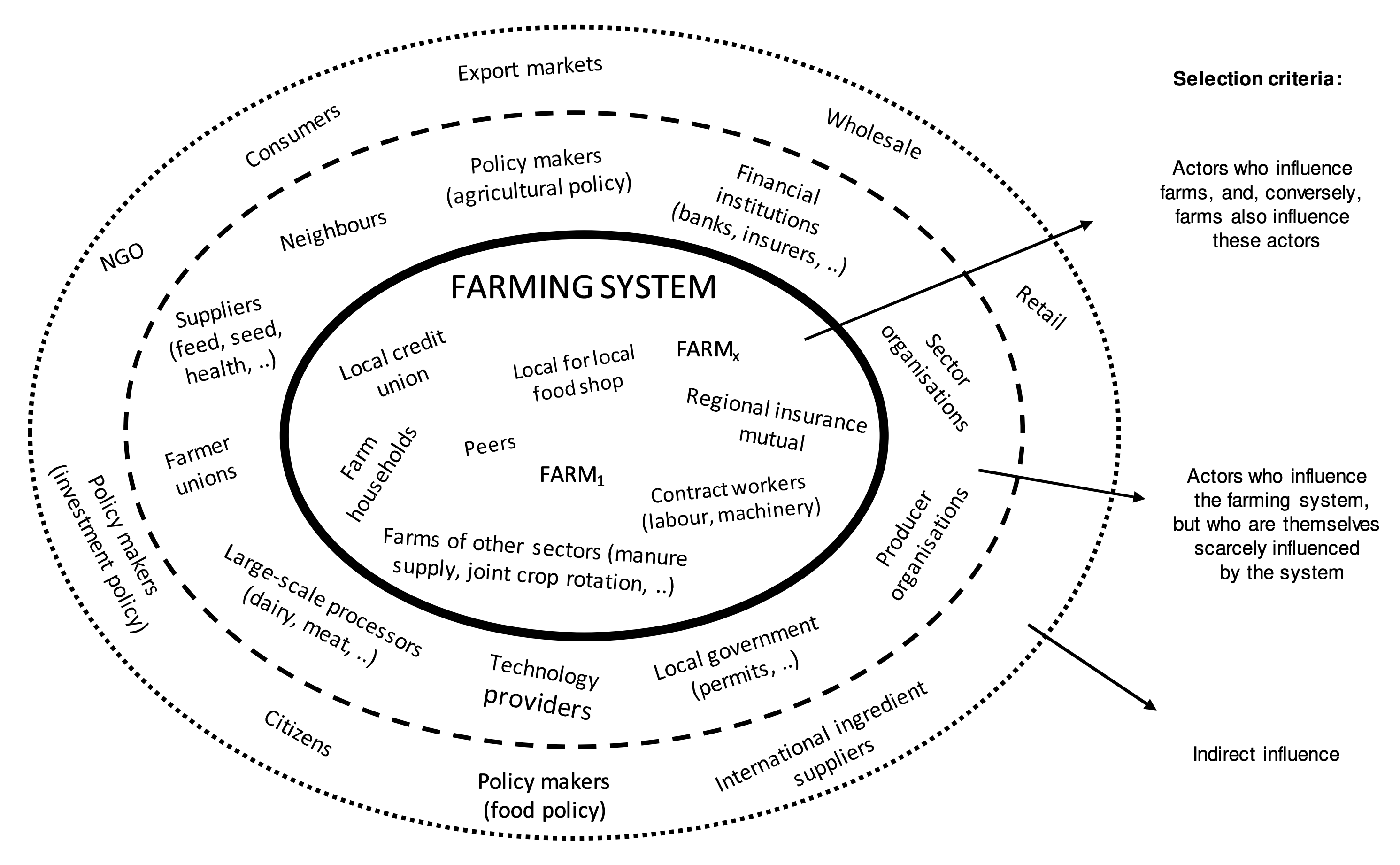
Key challenges (Resilience to what)
They characterise the challenges along four dimensions:
- Economic
- Environmental
- Social
- Institutional
The also distinguish two ways in how these challenges affect farming systems (adapted from Zseleczky and Yosef, 2014):
- Shocks
- Long-term pressure with inherent uncertainties
They recognise that distinctions between classifications can be somewhat arbitary, but state that the classification can be a useful ‘checklist’, see below.
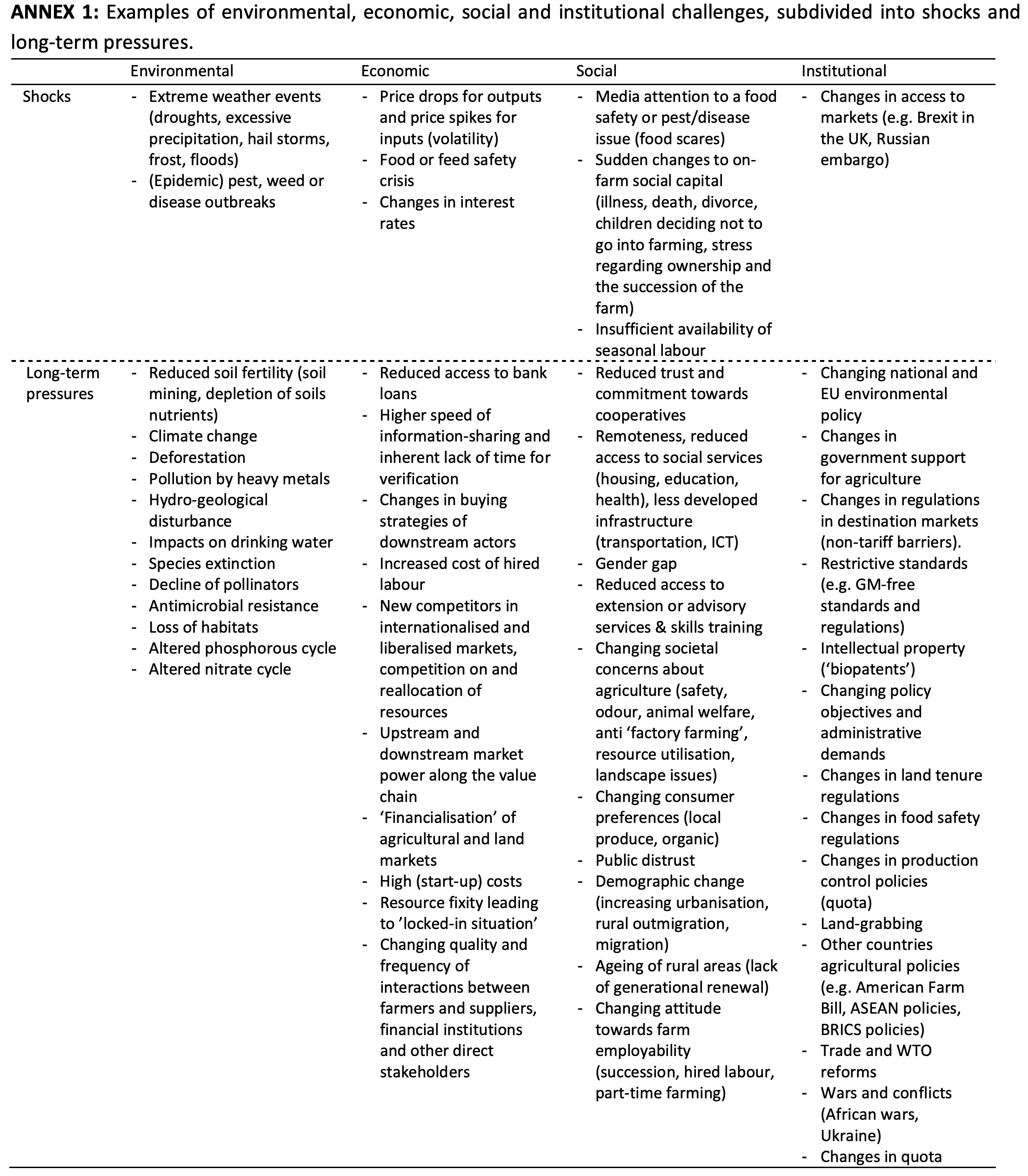
Essential functions of the farming system (resilience for what purpose)
SureFarm recognise that depending on a farming system’s geographic location, the functions of a farming system may differ.
They state it is useful, at a farming system level, to understand the variety of ‘essential functions’. In general, they find functions can be subdivided towards the provision of private goods and public goods.
Private goods, they refer to as:
(i) the availability of healthy and affordable food products,
(ii) the availability of other bio-based resources for the processing sector, including fuels and fibres,
(iii) the economic viability of farm as viable farms contribute to balanced territorial development, and
(iv) improved quality of life by providing employment and offering decent working conditions.
Public goods, they refer to as:
(i) maintaining natural resources in good condition,
(ii) protecting biodiversity of habitats, genes and species,
(iii) ensuring that rural areas are attractive places for residence and tourism, and
(iv) ensuring animal health and welfare.
They define these functions at the level of farming systems (not farms), implying that the framework is not primarily aimed at preserving individual (family) farms. They also recognise essential functions may change over time and also, that there may be functions which could be provided by other systems.
Resilience Indicators
The report proposes in terms of farming system resilience, it is best to start exporing:
(i) the dynamics of the essential functions (robustness), the ability to recover in three time steps after a shock to the farming system.
(ii) the relation between risks (shocks, long-term pressures) and responses (adaptability); i.e. the capacity to adjust responses to changing external drivers and internal processes, thereby allowing for development along the current trajectory, while continuing important functionalities (stability domain) (Folke et al. 2010).
(iii) the occurrence of tipping points (drastic system changes, regime shifts within one generation, changed identity) (transformability), see below.
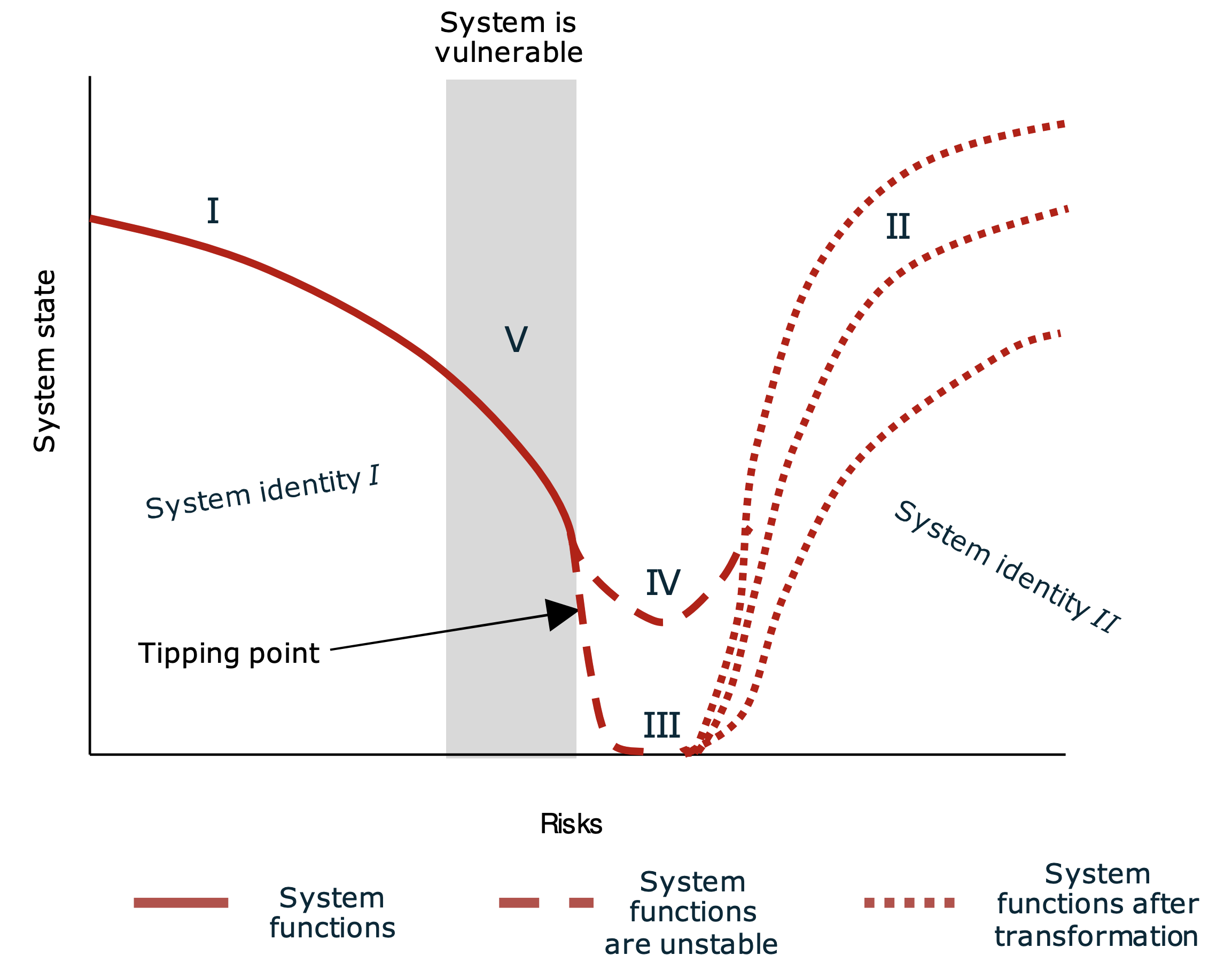
As farming systems are complex, the report suggests cycles can also be occurring at smaller scales (as sub system of a farming system) and therefore it can also be meaningful to explore robustness, adaptability and transformability at e.g. an individual farm or farm household level.
Resilience attributes
The report describes resilience attributes as contributing to the resilience of farming systems; i.e. they improve the resilience indicators. They state that, for instance they determine the speed of recovery, the variety of responses in the safe operating space (as shown below) or the pace at which a system can transform after a collapse (see the diagram above).
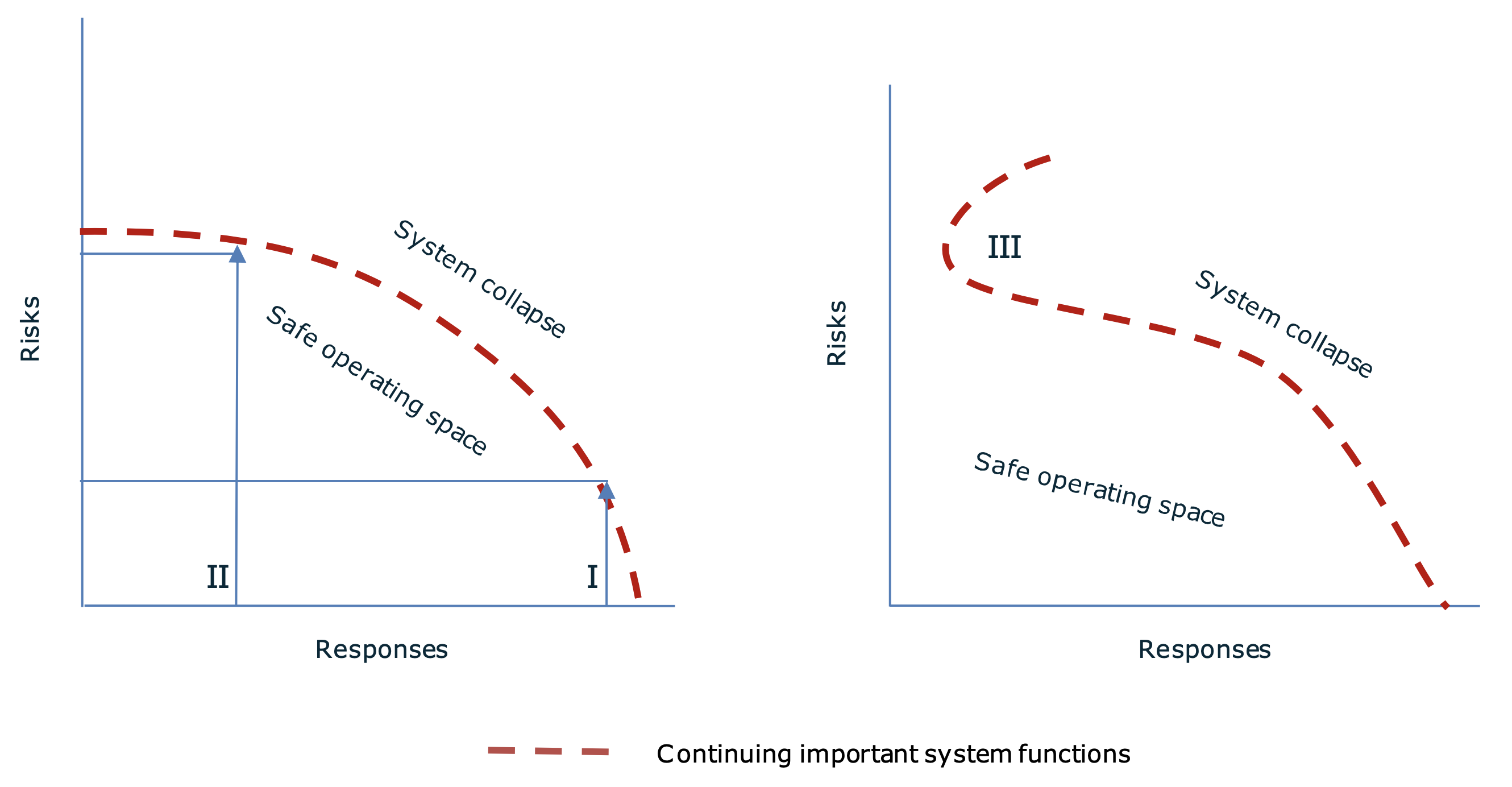
They quote the 13 identified general attributes contributing to the resilience of agroecosystems by Cabel and Oelofse (2012):
- Socially self-organised networks of e.g. farmers, consumers and the community
- Ecological self-regulation, e.g. by farmers maintaining plant cover and incorporating more perennials
- Appropriately connected, e.g. crops planted in polycultures and collaboration between chain actors
- Functional and response diversity, e.g. by heterogeneity within landscapes and farms
- Optimal redundancy, i.e. planting multiple varieties of crops, keeping equipment for various crops, and retrieving nutrients from multiple sources
- Spatial and temporal diversity, e.g. by a mosaic pattern of managed and unmanaged land and diverse cultivation practices
- Exposed to disturbance, dealt with by e.g. pest management and positive selection
- Coupled with local natural capital, e.g. by not depleting soil organic matter, and little need to import nutrients or export waste
- Reflective and shared learning, e.g. by record keeping and knowledge sharing between farmers
- Globally autonomous and locally interdependent, e.g. by less reliance on commodity markets and reduced external inputs, more reliance on local markets, and shared resources such as equipment
- Honours legacy, e.g. by incorporating traditional cultivation techniques with modern knowledge
- Building human capital, e.g. by investing in infrastructure for education, and support for social events in farming communities
- Reasonably profitable, implying that farmers and farm workers earn a liveable wage, and the agricultural sector does not rely on distortionary subsidies
These 13 attributes are specified within their resilience framework as to how they contribute to specific types of resilience, i.e. robustness, adaptability and transformability. They further suggest that links between some resilience indicators and the 13 attributes, although proven under some conditions, need to be empirically tested under different conditions. They focus on those attributes that more closely fit the 3 main processes identified in their paper:
- Agricultural production
- Farm demographics
- Governance processes
They argue while resilience attributes might be studied in isolation, the complexity of farming systems requires an integrated consideration.
The diagram below presents their integrated analysis of selected attributes.
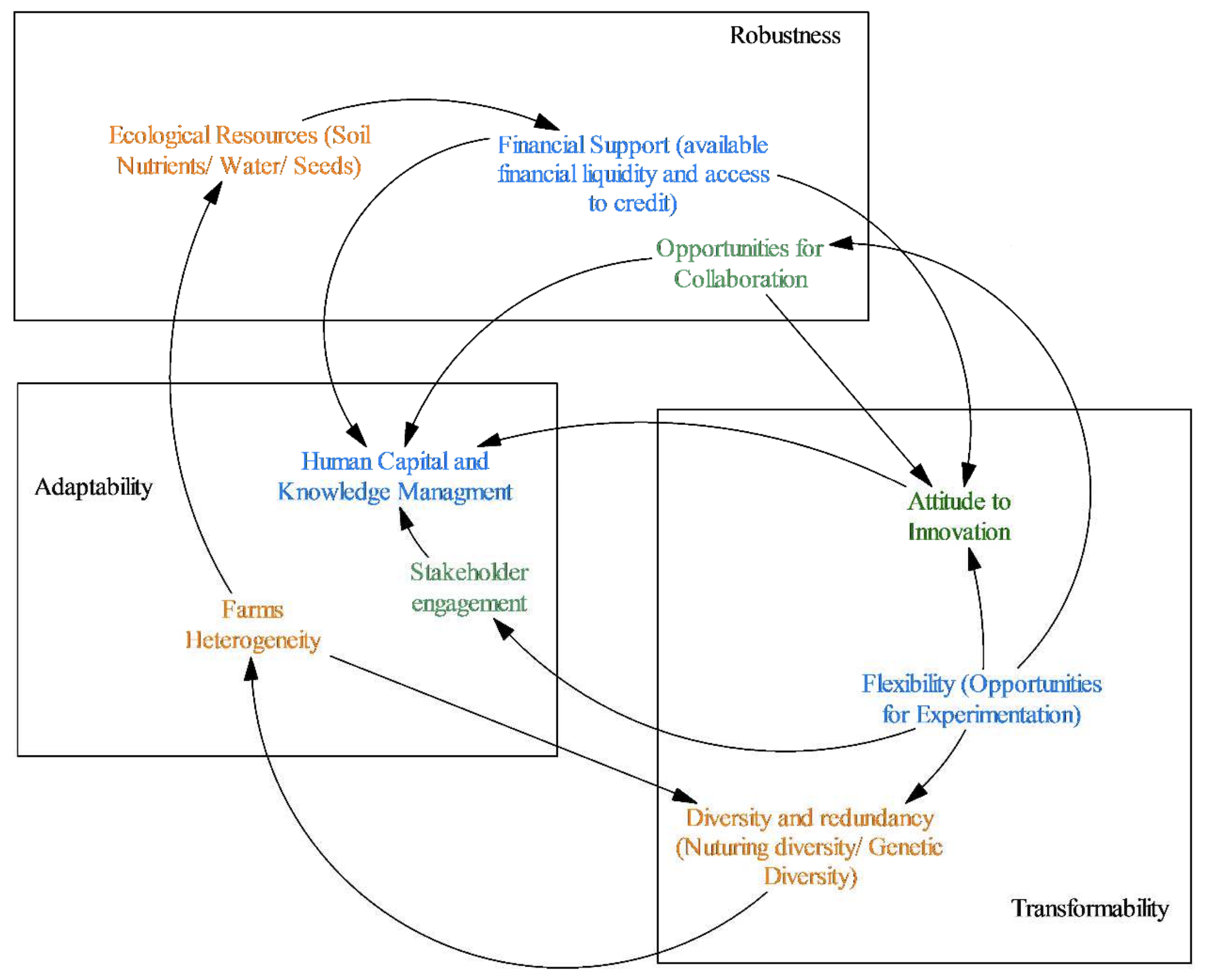
The integrated assessment approach, illustrated above, they have designed to understand synergies among attributes and recognise their contribution to resilience and also how they may contribute to risk. In understanding an integrated approach they propose that this also demonstrates trade offs between different attributes and resilience indicators.
Retrieving attributes through co-creation.
Due to the importance of diversity and stakeholder engagement in many of the proposed resilience attributes, they report proposes that co-creation seems a suitable approach to identify such attributes. Co-creation refers to the participation of end-users in the product and services definition (Von Hippel, 1987), more recently also applied by companies to design value adding strategies (Prahalad and Ramaswamy, 2004) and by the public sector in the policy making process (Voorberg and Tummers, 2014). The Resilience Alliance (2010) proposed a participatory approach to assess resilience, including the identification of resilience attributes.
In the context of farming systems a virtual co-creation platform has been developed by SureFarm:
“The access to the virtual platform is private and limited to a selection of stakeholders. Between 40 and 60 key senior opinion stakeholders with proven experience in agricultural production, farm demographics and governance issues are convened to participate in the virtual platform to co-create breakthrough solutions from a broad approach. A balanced selection of all the stakeholders – farmers’ organisations, insurance companies, banks, value chain actors, policy makers, environmental and consumers’ organisations and research institutes – is ensured as well as the geographical origin from EU Member States.”
The co-creation process they use follows the design thinking approach that comprises five phases they have developed:
- Gather information (which is the need);
- Generate ideas (get breakthrough ideas);
- Make ideas tangible (learn how to make ideas better) and
- Share the story (inspire other towards action) (Brown and Wyatt, 2010).
Their design thinking process is led by an appointed expert, who is in charge of encouraging the participation of the community members.
“With this purpose different activities can be performed in the co-creation platform in addition to the debates, like sharing videos, pictures, documents and participating in gamification features like questionnaires, points and levels and weights. The results obtained through the virtual co-creation platform are discussed at a local level by organising local co-creation workshops in the case study regions. The stakeholders identified within the farming system boundaries in case study regions are invited to participate in the local co-creation workshops. With this double-level, co-creation process, the feasibility of the virtual co-creation platform results are tested at case study level, (Meuwissen et al 2018).”
Non-resilience
They identify that lack of the type of attributes described in their framework (shown above) may not necessarily lead to system collapse. They nevertheless refer to Cumming and Peterson (2017) who describe among others the following mechanisms contributing to vulnerability and collapse: Ecological degradation and excessive resource consumption, too much complexity, sunk cost effects, lack of diversity, and external disruptions.
They state that sunk cost effects were also described by Williamson (1987): That a high level of asset specificity could reduce the scope for adaptation and transformation. They discuss that as it is well known economic agents commonly have a choice between special purpose and general purpose investments. While the former could permit larger cost savings than the latter form of investment, they state special purpose investments are also risky.
They explain this is because, if new conditions arise, specialised assets cannot be redeployed, without sacrifice of productive value (Williamson, 1987). The report states this causes imperfect resource mobility and reduces the room for transformation.
Difficulties in applying the framework
They have found that their preliminary case illustrates the difficulties in applying the framework. For instance, key risks and essential functions depend on stakeholder perspectives and e.g. the occurrence of recent shocks, thereby reinforcing the need for clarity on spatial, functional and temporal boundaries of the system under consideration.
A further identified challenge of the framework by the project, is the identification of meaningful indicators to reflect the performance of a selected system function over time. They state that single parameter indicators likely forego the complexity of farming systems including historical context. They therefore think there may be a need to move to composite indicators or simultaneous analysis of multiple indicators.
A further identified issue is that the example 13 attributes start to live their own live’s, i.e. they are taken for granted without being verified, yet, for example, it has been often shown that the attribute diversity contributes to improved resilience to climate variability and change (Gil et al., 2017).
However, they state that this is not the case in all situations, and resilience to climate variability and change does not necessarily imply that systems also have resilience to technological change. Although the example attributes are useful for prototyping, they find that exact interpretations in different context needs further elaboration and evidence.
In addition, they find this elaboration will be challenging in itself, as most attributes (especially under adaptability and transformability) are slowly changing variables (Carpenter et al. 2011). “[..] Learning about slow variables takes a long time, so it is easy to miss important processes or focus attention on the wrong hypotheses”. Also, preliminary case work illustrates that different types of resilience can occur simultaneously.
Before concluding on ‘the resilience of a system’, they believe it needs to be understood which types of resilience best suit certain risks and system functions. In current literature the word ‘resilience’ is used abundantly. Their framework provides structure and definition to this multi-faceted concept. It also stipulates a structure to discuss sensitive topics among stakeholders, such as professional reorientation, negative feedbacks between attributes, stakeholder awareness and action plans regarding resilience of farming systems, and disputes about short-term versus long-term solutions.
Due to its multiple entry points (e.g. top-down and bottom-up), they expect that the framework can be used by researchers to retrospectively understand the dynamics of sustainability in farming systems, and by decision makers to pro-actively identify differentiated attributes, i.e. resilience-enhancing strategies, across EU farming systems depending on context-specific risks and available resources.
Information sources and further information
The SureFarm report on the resilience framework for EU agriculture

